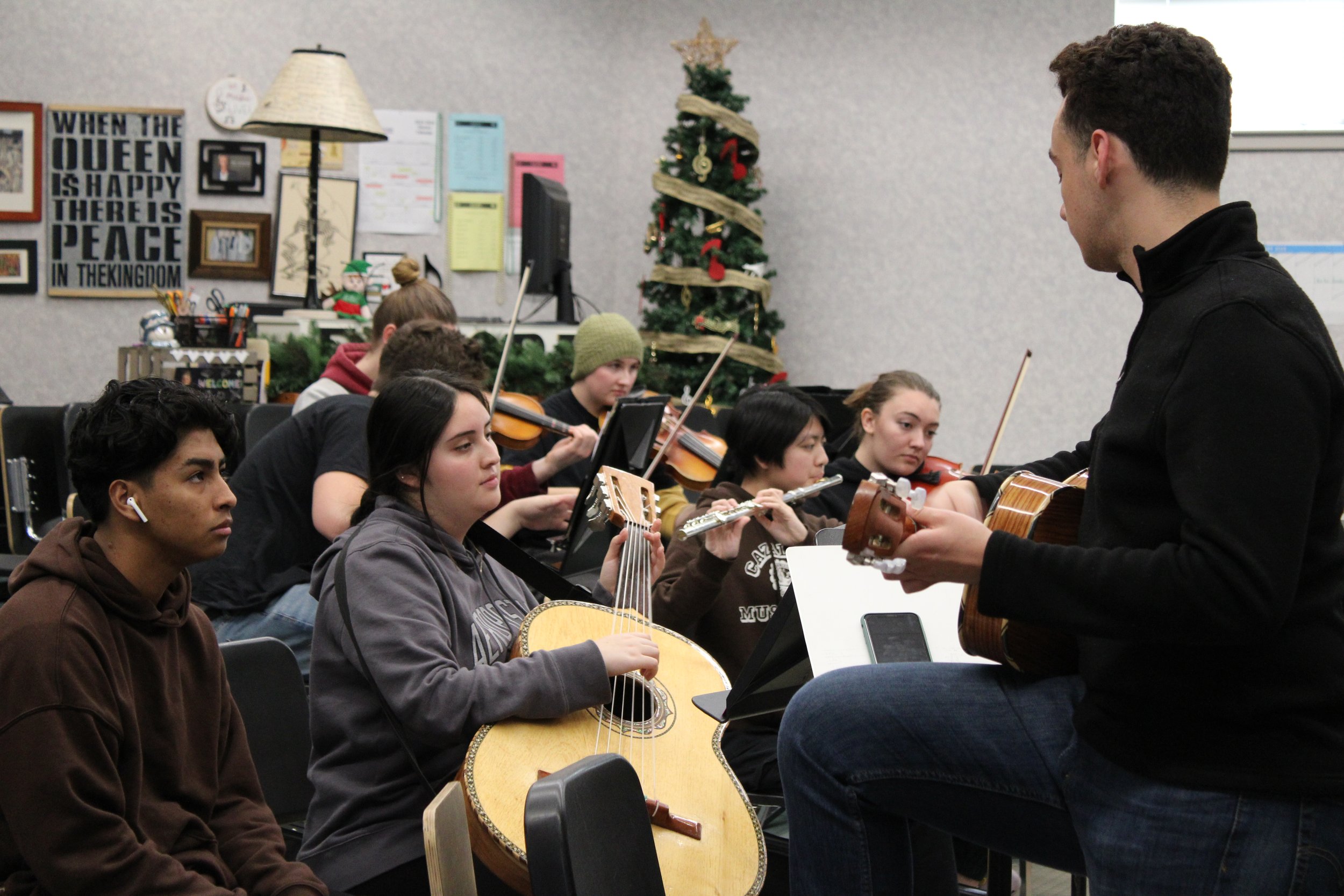Mariachi Club
Matthew Bowker conducts his beginning mariachi group (Jasmine Arroyo, The Puma Prensa)
By Jasmine Arroyo, Business Manager
The longstanding and impressive musical groups that exist at Maria Carrillo, such as our classical band, jazz band, and orchestra have a well respected presence on campus. If you weren’t able to watch the October band concert, you might have missed the debut of an up and coming group on campus; mariachi club.
For those who are new to the genre, mariachi is a distinct type of regional Mexican folk music dating back as early as the 18th century with both European and indigenous elements. It has evolved over time in regions of western Mexico and is often characterized by its distinct rhythm and trajes de charro worn by the musicians. Today, it serves as an emblem of cultural heritage and source of pride to many Mexican Americans.
A mariachi is composed of violins, trumpets, guitars, a singer, and sometimes a harp, but assistant musical director Matthew Bowker explains there are two instruments in particular that, “make a mariachi a mariachi- and those are the vihuela and guitarron.” Both of these instruments might appear to be smaller or larger versions of the guitar you are familiar with, but are fundamental in order for the group to classify as a maricachi. The guitarron in particular is a big brass guitar capable of projecting sounds without the need for amplification.
Bowker first introduced the idea of forming a mariachi group to students last school year. Now, he serves as Carrillo’s mariachi director where his love for the genre and experience as mariachi director at the Luther Burbank Center for the Arts is reflected in his leadership of around 60 beginner and advanced musical arts students. Some of these students have grown up listening to the genre of Mexican folk music their whole lives while others are just becoming familiar with it. Nonetheless, their enthusiasm is the same. “I think it’s important to have students learn about different cultures in a fun and engaging way,” said senior Abigail Mills who is in her first year of the club.
Northern California has yet to see a strong youth mariachi presence as a part of public school curriculum, whereas areas in southern California and Arizona have adopted marichi as their main music program. These regions of the country are highly recognized centers for competition and often draw national attention. “It's a cutthroat thing and I eventually want to get something similar started over here and us to the hotspot of mariachi,” said Bowker. For now, mariachi is on track to become a class next school year. Its official adoption into Carrillo’s music program would offer students more options, as well as the opportunity to learn guitar.
Another benefit of mariachi becoming a class at Carrillo is its function as a cultural bridge between students. Senior Marta Leon Delgado comes from a family of musicians and grew up listening to mariachi as a part of her Mexican-American culture. She wasn't always drawn to the genre, though. Through musical camps, she was encouraged to learn the guitar and then guitarron, eventually leading her to become a member of the Luther Burbank Center for the Art’s mariachi ensemble.
With more than four years of experience playing mariachi under her belt, joining Carrillo’s club seemed obvious, but she also knew that beginners interested in the club may have some doubts. “I've seen people embarrassed to join because you don't really see a lot of youth mariachi around here,” commented Delgado Leon regarding the difficulties of being the first school with a youth mariachi group in the area. The absence of cultural representation may have deterred students in its early formation of the club, but the adoption of the course into school curriculum could highlight and celebrate campus multiculturalism.
“I think seeing other people express themselves and seeing it's okay to express different cultures motivates us,” said Delgado Leon. She hopes that mariachi’s presence on campus- and on stage- will draw in a larger range of students to join. “We are meant to break barriers and feel like students are represented,” added Bowker. Ultimately, Bowker’s only criteria for interested students is that they are willing to, “have fun and learn something new.” He is excited to showcase the club again in the series of February band concerts where he hopes to have an hour long set. Until then, mariachi club will continue practicing, so I suggest marking your calendar for their show in February-you won't want to miss it.

